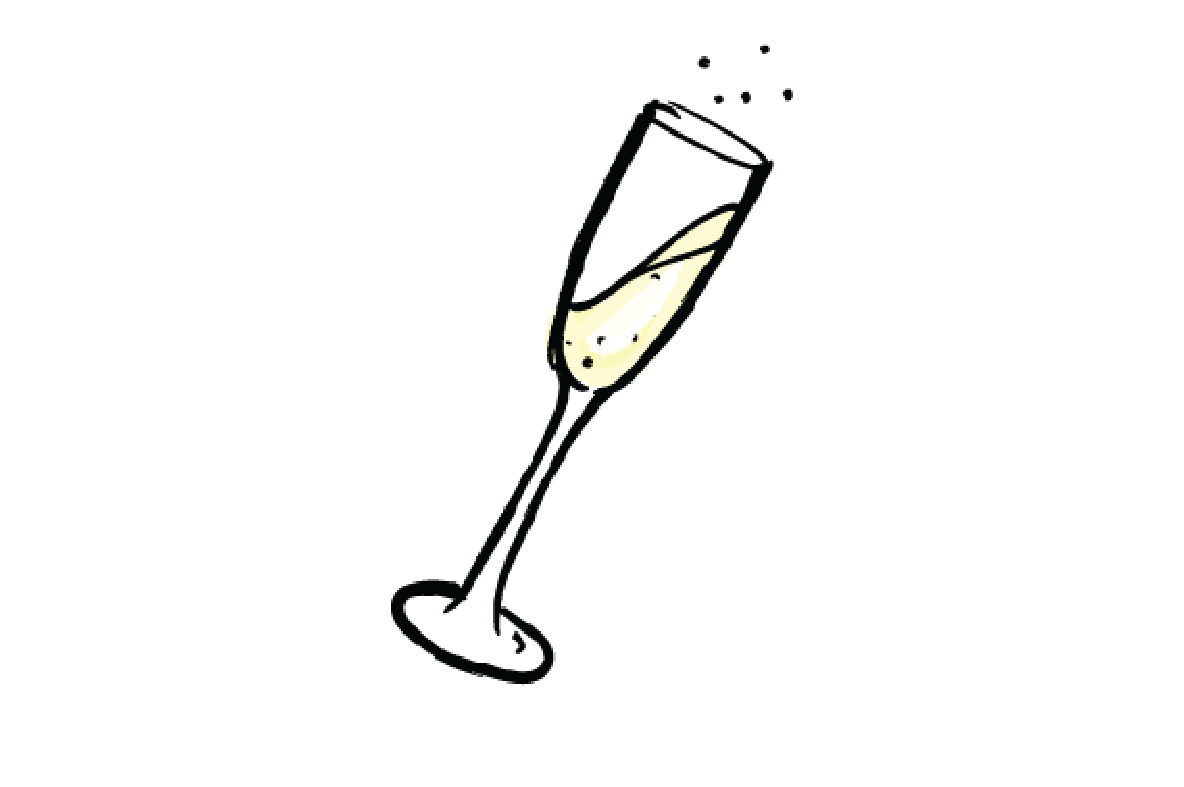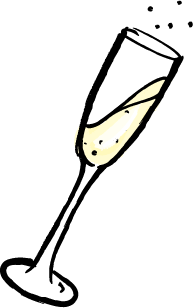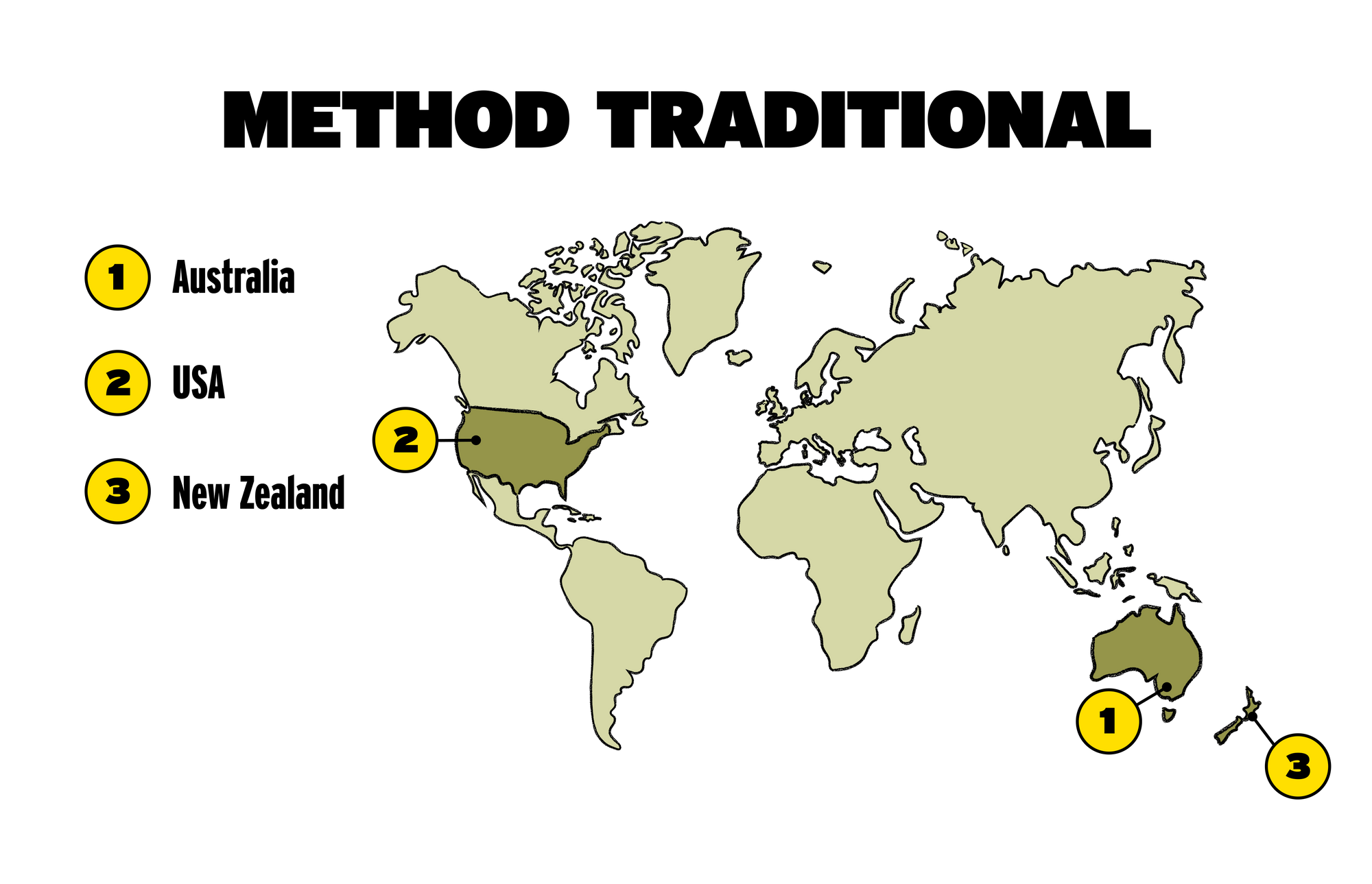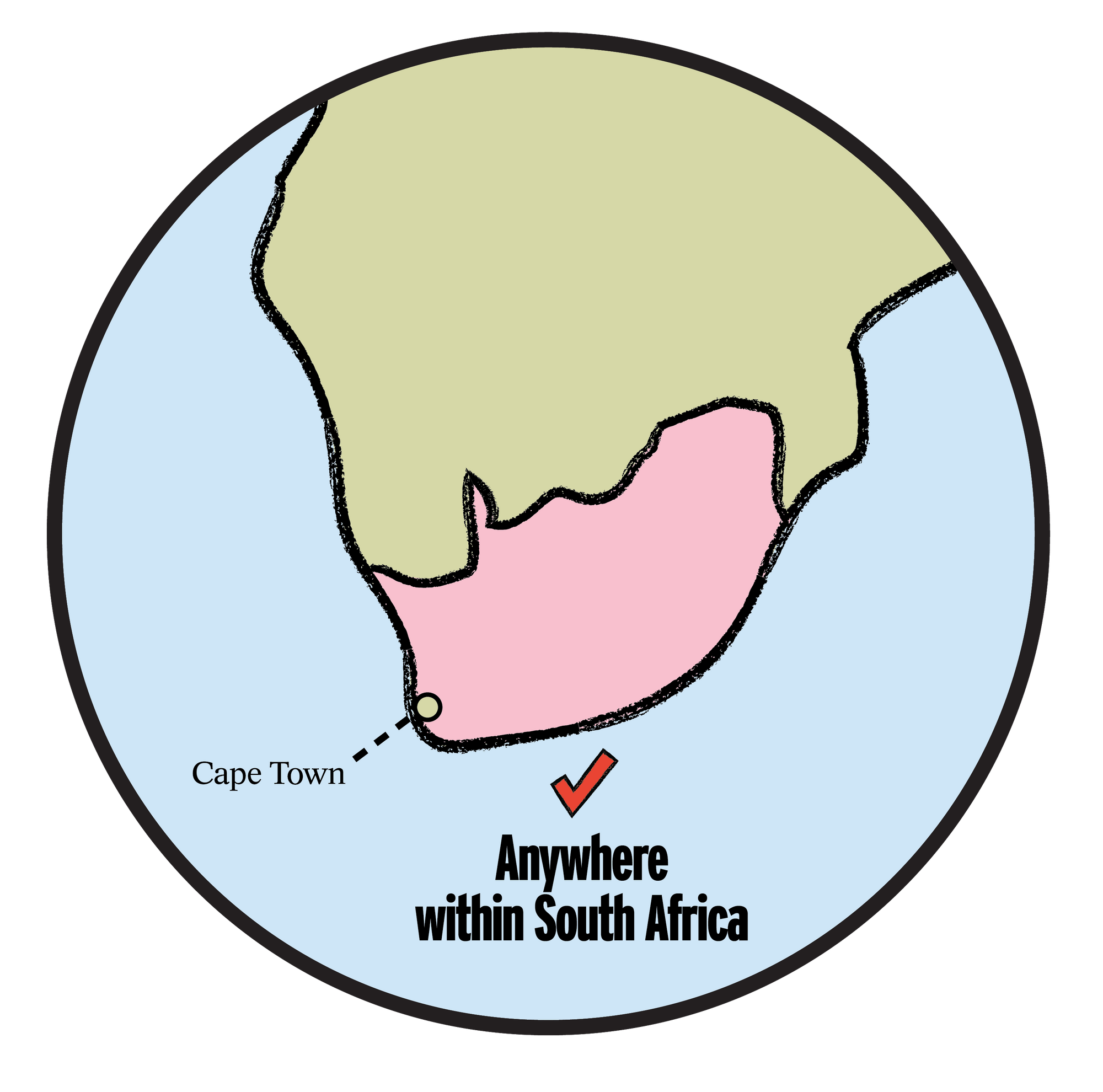

Sparkling wine is pretty self explanatory. Does it have bubbles? If so, it's sparkling! There's actually a few ways to make wine sparkling. We'll break down the main methods plus the different fizzes from around the globe.

Sparkling wine is pretty self explanatory. Does it have bubbles? If so, it's sparkling! But each country in the world renders these wines slightly differently, using a different mix of grape varieties. Plus, there's actually a few ways to make wine sparkling. We'll break down the main methods plus the different fizzes from around the globe.
Methods--red
I. TRADITIONAL METHOD (aka Methode Champenoise)
Surprisingly not the first (more on that later), but generally considered the best. The Champagne method, which, thanks to the French wine legal eagles must legally be called the traditional method outside the Champagne region, is the classic sparkling vinification process.
Invented in England sometime around 1650, and then subsequently made famous by Benedictine monk Dom Perignon, who lived in the Champagne region, around the year 1700.
It is generally believed to make the highest-quality, longest-lived, most complex sparkling wines in the world. It is however also the most expensive, labor-intensive, and time-consuming! Sadly you can only have good Champagne, or cheap Champagne. Rare to find both.
The traditional method requires a secondary fermentation to take place inside the bottle. So a wine is made, put into bottle, and then a mixture of sugar and yeast (known as the liqueur de tirage) is added.
This kicks off a second ferment, resulting in CO2 (yay, bubbles!), a touch more alcohol and finally, dead yeast cells known as lees (again, more on that later!) The wine ages on these lees for a time, creating texture, richness and complexity in the wine.
Before the wine is ready to go however, winemakers will remove the lees by a process called riddling (the French call it remuage). They invert the bottle until the sediment sits in its upside-down neck and can be frozen. When the cap is removed, the bottle’s pressure forces the sediment out, at which point a mixture of sugar and wine called dosage can be added, along with a final cork. Hooray!
Yes, there are cheaper and easier ways to make bubbly wine, but winemakers invest in the traditional method because it produces such high-quality sparkling wines.

II. ANCESTRAL
Ok so we said before that the Champagne method is probably the best, if you want your fizz complex and $$$. If you are looking for the OG method however, this is where you want to land. The ancestral method produces wines called petillant naturel, often called pet nat these days. This is the original method of making wine fizz - no tricks, one ferment, away you go.
A wine is made in the normal manner, however whilst it is still fermenting, it gets whipped into bottle and a cap put on it. The ferment bubbles on its merry way, producing fizz as it ticks along. If the winemaker got the timing right, the wine will be nearly dry (often these styles have a touch of sugar remaining, just enough to render them fruity) and playfully bubbly.
These styles are fun and frivolous, and certainly don't have the long-aged complexity of Champagne, but are perfect for spring afternoons and picnics in the park.

III. TANK/CHARMAT
Plenty of people love sparkling wine (us very much included), but not everyone loves the rich, complex style of Champagne, or indeed wants to pay for it! So in 1895 a clever Italian winemaker named Federico Martinotti developed a method for creating sparkling wine speedily. Sadly, he was a better winemaker than he was businessman, so in 1905 a Frenchman named Eugene Charmat refined the idea, patented it and the history books did the rest. We know refer to this method as the Charmat, or Tank Method.
This process begins, like the traditional method, with the creation of an uncarbonated base wine. This wine is mixed with the liqueur de tirage, then put in a large stainless steel pressure tank. The yeast and sugar cause a second fermentation in the closed tank, which is held under pressure so the carbon dioxide from the fermentation is forced into the wine!
This method only takes between two and six weeks, after which the fizzy wine is immediately filtered and bottled.

IV. CARBONATION
The simplest method, that results in the simplest wines. Wine is made as normal, and then force carbonated - ie CO2 gas is forced into the wine.
Because the wine is not given the time to fully integrate these bubbles, the bead of the wine is generally quite coarse and the bubbles don't last as long once the bottle is open.
A lot of the specific sparkling wine styles from around the world are centred on a particular region. This is sometimes due to tradition, other times due to climatic benefits, quite often both!
Styles--aromatic
Champagne
The Champagne region is in the north east of France, just over an hours drive from Paris. The region is nearly entirely devoted to sparkling wines - there are a few traditional table wines, but the vast majority is made as sparkling wine. The main grapes here are Pinot Noir, Chardonnay and Pinot Meunier, along with a few other minor players. Some styles you might see include Blanc de Blancs - translates to 'white from whites', and is a white wine made from white grapes, more often than not Chardonnay. Blanc de Noirs - translates to 'white from blacks', and is a white wine made from red grapes, often Pinot Noir alone, or blended with Pinot Meunier Rosé - we think you can figure this one out? Interestingly though, Champagne is one of the few regions where you can blend red and white wine to make a rosé.

Method Traditional
This is exactly the same process as Champagne, however the name is used everywhere else in the world. Essentially the French have trademarked the name and the process (they call it Methode Champenoise), so if the same wine is made anywhere else, it's referred to as Traditional Method. Most commonly seen in Australia, USA and New Zealand.

Cremant

The French are so strict that they won't even let other parts of France call their sparkling wines Champagne. Made identically, A cremant is a sparkling wine from other regions of France, so you have Cremant de Bourgogne from Burgundy, Cremant d'Alsace from Alsace etc.
Prosecco

After France, the Italians are the most prodigious producers of fizzy wine in Europe. The best-known example is definitely Prosecco, which comes from the Veneto region in the north of Italy. Here the local grape variety Glera is used to produce a lighter style sparkling that has become famous the world over. These wines are made using the Charmat method. There's a similar situation brewing here as in Champagne - the local winemakers have banded together to try and ban other wineries across the globe from using the name Prosecco. This has incensed other winemakers, including our own in Australia, where Prosecco has become a part of the wine landscape. Watch this space!
Franciacorta

Less well known in Italy, but regarded more highly, is Franciacorta. These are made in the northern region of Lombardy, using the traditional method. Like Champagne, they are aged for an extended period on lees to increase richness and complexity, Here the grapes used are Pinot Noir, Chardonnay and Pinot Blanc. Consider it Italian Champagne, just don't tell the French we said so.
Lambrusco

In northern Italy, surrounding the city of Bologna, is the region of Emilia Romagna. Here we find probably the world's most famous sparkling red wine - Lambrusco. Made from a large range of local varieties (all grouped under the heading of Lambrusco), this is a medium-bodied sparkling wine that can be both surprisingly good or disappointingly plain. The variation comes due to the fact that various production methods are used - some producers use the Charmat method, others the traditional method, and a handful the ancestral method. From rustic to refined, the wines will all be savoury and fruity at the same time, with lots of blackcurrant, rhubarb and peppercorn notes. A great wine for charcuterie and antipasto.
Moscato

The last piece of the Italian sparkling puzzle is Moscato, a semi-sweet, semi-sparkling wine made across Piedmont, in the north of Italy. Made from the grape Muscat Blanc a Petit Grains, this is a fruity wine made for fun times. The slight fizz to the wine is known as frizzante in Italian and is used to designate wines that aren't fully sparkling. This is made using the Charmat method, and is chilled when the wine reaches around 5% alcohol to kill the yeast, then filtered and bottled.
Cava

Spain wasn't going to miss out on the act, and makes some great sparkling wines that labelled under Cava. Unlike Champagne, this isn't a geographical designation, and indeed Cava can be made in a few different regions across Spain. The cultural hub for it however is in the Penedes region, just outside Barcelona. The grapes used are mostly local ones - Xarel-lo, Parellada and Macabeo, and the wines are made using the traditional method, but generally not aged for as long as Champagne.
Sekt

The German sparkling wines are known as Sekt, and have no rules over grape variety, although Pinot Noir and Riesling are traditional. The method is predominantly Charmat, although some premium versions use the traditional method.
MCC

An acronym for Method Cap Classique, the stylised way that South African producers refer to the production of sparkling wines. The traditional method is used, and the wines are usually premium in nature, in an attempt to mirror the success of Champagne. Pinot Noir and Chardonnay are used almost exclusively.
Common terms--racy
Some commonly-used terms in the production of sparkling wines
Lees: This is a bit of wine-science term and is not only used in relation to sparkling wines.
The word is used to collectively describe any dead yeast cells or grape particles that remain trapped in the juice as it’s fermenting before it goes into the bottle.
If juice/wine spends a long time in contact with these lees (which in large amounts take the form of a wet paste, or sludge – attractive, no?), it can take on some of the textural characteristics of the lees – in a good way.
It makes the wine creamier, thicker, richer. But this only becomes apparent after at least a year, so some patience is required!
Disgorge: Once the wine has spent some time hanging out with all those rich lees and is starting to become a lovely wine, it's time to ditch the lees so they don't end up in our glass. The bottle is inverted until the sediment sits in its upside-down neck and the neck can be frozen. When the cap is removed, the bottle’s pressure forces the sediment out in a semi-frozen plug of goo, and a fresh cap is put back on the bottle.
Dosage: Sometimes, once the wine has been disgorged, it may still be excessively acidic for the winemakers preference. To balance this out, a small amount of sugar mixed with still wine can be added to the wine. This is called dosage.
Bead: Finally, let’s talk bead. This term is exclusive to sparkling wines, and is simply a different way of referring to the bubbles in the wine.
A fine bead means you’re sipping quite small, delicate bubbles, which create a smooth sparkling wine that caresses the palate like silk. A coarse bead indicates that bubbles in the wine are quite large and easily identified.
This results in a frothy, very sparkling wine that can have the texture of lemonade. Imagine the difference between mineral water and soda water – or Guinness and Red Bull!
FAQ
Does sparkling wine have alcohol?
Yes, all wine contains alcohol, unless it has been de-alcoholised by some process.
How do you drink sparkling wine?
Sparkling wine should be served chilled, either in a thin glass called a 'flute' or a small white wine glass.
What is the serving temperature of sparkling wine?
Sparkling wine is best served chilled, around 10 degrees celsius.
What kind of glass do you serve sparkling wine in?
Sparkling wine drinks best from a thin, tall glass that is known as a 'flute' or in a small white wine glass.
How long can you keep unopened sparkling wine?
Young, simple sparklings can cellar for a couple of years, and premium champagnes can cellar for decades!
About the Author
Banjo Harris Plane is the three-time winner Sommelier of the Year Australia and a certified advanced Sommelier through the Court of Master Sommeliers. He first cut his teeth in the wine industry working as a sommelier in Australia's best restaurants, before starting multiple businesses in the space of a few years... these included two restaurants, a wine import business and co-founding Good Pair Days!
Do you know your wine personality? If your answer is no, take our quiz to find out which wines to pick up next and build your box!
Build my box





